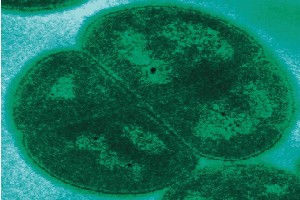Deinococcus radiodurans
A Microbial Biorealm page on the genus Deinococcus radiodurans
Classification
Higher order taxa
Bacteria; Deinococcus-Thermus; Deinococci; Deinococcales; Deinococcaceae; Deinococcus
Species
D. radiodurans, D. radiodurans R1
Description and significance
Deinococcus radiodurans was first discovered in 1956 in a can of ground meat that had been treated with large doses of radiation to remove all hazardous bacteria from the product. Since then this species has been intensely studied for its radiation resistant properties. It has been known to withstand radiation levels of up to 1,000 times that which would kill a normal human, living up to its latin name, "strange little berry that withstands radiation." D. radiodurans has since been isolated from a variety of habitats, mostly soil and feces based. Being a mesophile, this species grows relatively well between 30-37°C.[2]
Genome structure
The genome of D. radiodurans consists of four major parts. The complete sequence of the R1 strain has 3,284,156 base pairs made up of two circular chromosomes (2,648,638 and 412,348 base pairs), a major plasmid (177,466 base pairs), and a small plasmid (45,704 base pairs). No current research shows whether or not these plasmids contribute specifically to functionality or virulence. However, it is known that multiple copies of each gene are found on all the chromosomes and plasmids, which most likely contributes to its amazing repair capabilities associated with its radiation resistance.[1]
Cell structure and metabolism

D. radiodurans is a gram-positive bacteria that usually forms in spherical pairs or tetrads.[4] The most interesting aspect about the cell structure of D. radiodurans is that it keeps 4-10 copies of all its genes at any given time depending on its current stage of growth. Many researchers believe this relates to the reason why it can withstand so much radiation. This ability does not rely on some "magic" gene that protects it from radiation, rather, it seems that D. radiodurans is able to more efficiently repair double strand breaks in its DNA that result from radiation damage thanks to these extra copies and a few other special proteins.[2]
Ecology
D. radiodurans has been found in a wide variety of environments which therefore make its "natural" habitat difficult to define. It is often cultured in the lab from the feces of animals, such as elephants. However, many scientists have found it peacefully existing in the soil of various settings, including the rocky granite of Anartica's dry valleys. These numerous soil dwellings have led many to classify D. radiodurans as a soil bacteria. There is no current findings that suggest that D. radiodurans significantly interacts with other organisms in nature.[7]
Application to Biotechnology
There has been much research done on the possible uses of D. radiodurans in bioremediation. Currently, the organisms that are used for chemical and biological clean-up are not resistant to radiation. Since D. radiodurans is very resistant to radiation, scientists are interested in using the bacteria to clean up waste sites containing hazardous materials. D. radiodurans is already known to be able to break down solvents such as toluene, but work needs to be done to try and make the bacteria capable of breaking down other compounds and materials that are common at radioactive waste sites.[7]
Current Research
Due to its interesting cell structure and radiation resistant properties, D. radiodurans has been the focus of many current research groups.
Since it is thought that the radiation resistance of D. radiodurans relies heavily on the cell's specialized proteins and cell structure, much research has been done to elucidate the structures of these proteins. One such protein whose structure in this bacteria was recently discovered is thioredoxin reductase. This reductase is an enzyme that is found to be a crucial player in the cells response to oxidative stress, including double-strand DNA breaks.[4]
Yet another interesting point about this species is that it is able to quickly and accurately repair double-strand breaks in its DNA without the normal RecBCD enzyme that is present in other bacteria. However, current research has shown that D. radiodurans contains a gene sequence that encodes for a protein that is very similar to the RecD enzyme found in E.coli. This significant finding suggests that this RecD-like protein in D. radiodurans is an important part of the repair system it uses. It had been shown that deletion of the recD gene has led to substantial increase in sensitivity to radiation.[5]
Perhaps the most interesting current research taking place concerns whether or not it is possible to genetically make other bacteria as radiation resistant as D. radiodurans. One such research team in China is debating this topic. Specifically, they are trying to insert an expressive recombinant Mn-SOD protein from D. radiodurans into E.coli BL21. The real challenge here isn't trying to insert random proteins into other species, but is making the protein expressive and recombinant, essentially self-sustaining in the new species. So far this research has not been completely successful, however it has as the team put it "provided the foundations for further studies and applications of the recombinant Mn-SOD."[6]
References
7. DeWeerdt, S. E. The World’s Toughest Bacterium. Genome News Netowrk, July 5, 2002
Edited by Edwin Cook, student of Rachel Larsen and Kit Pogliano
